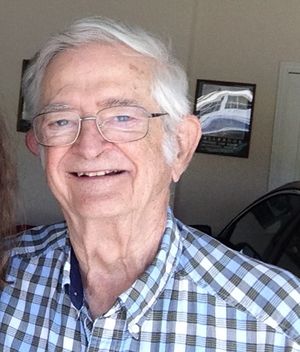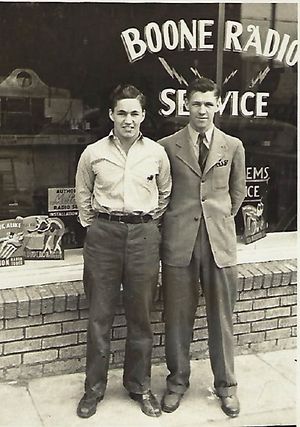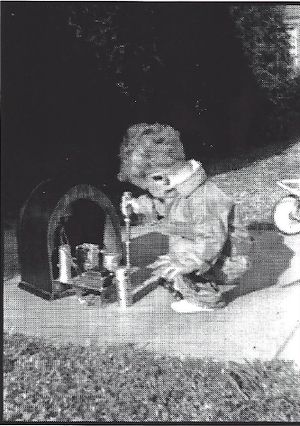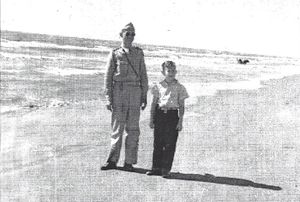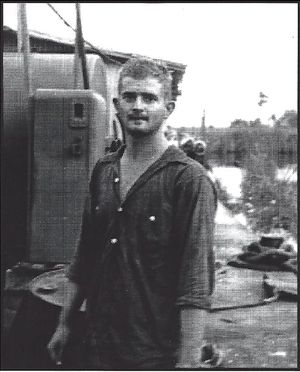James V. Boone
- Birthdate
- 1933/09/01
- Death date
- 2020/05/12
- Associated organizations
- Tulane University, United States Air Force, National Security Agency, TRW, National Cryptologic Museum Foundation, IEEE
- Fields of study
- Electrical engineering
- Awards
- Exceptional Civilian Service Award, National Security Agency, 1975, Distinguished Alumnus Award, Tulane University School of Engineering, 1994 Certificate of Recognition, National Reconnaissance Organization, 2004
Biography
Introduction
James Virgil Boone merged personal and family loves of electronics, aviation, and patriotism to spend his career in the United States' security establishment during the Cold War (1946-1990). A striver and technical pioneer all through life, he helped innovate the use of electronics in collecting data transmitted to and from the satellites and spacecraft of the Soviet Union from both satellites and ground stations while working at the U.S. Air Force, the National Security Agency, and TRW Incorporated.
Childhood
Boone was born the only child of Dorothy Bliss and Virgil Bennett Boone, on 1 September 1933 in Little Rock, Arkansas, USA. From an early age, Boone developed an interest in electronics through his exposure to the equipment in his father's business, Boone Radio Service (see first two photos below). Seeking to support the U.S. war effort in his middle age, Boone's father sold his electrical supply and radio shop and moved the family in 1942 to Grand Isle, Louisiana. There he joined the first Civil Air Patrol (CAP) on the U.S. Gulf Coast and serviced the avionic systems of the airplanes combating the German U-boats attacking shipping offshore (see third photo below). By 1944, with the decline of the U-boat threat, the Boones moved to Metairie, just outside New Orleans, where Virgil serviced Sperry Gyroscope Company's gyro-compasses for ships arriving in port from the Mississippi River or the Gulf of Mexico.
Education
Jim Boone enrolled at Warren Easton High School and joined a Boy Scouts of America troop founded by his father. It was hosted by a Catholic church while welcoming Protestants, making it an unusual inter-faith youth organization in the area. After attaining Eagle Scout and the Order of the Arrow and graduating from high school as his class president, Boone was accepted at Tulane University in 1951 on a scholarship with the intention of becoming a pilot. After failing the depth perception part of the Air Force eye exam for flight school, he joined the Air Force Reserve Officers Training Corps (ROTC). Boone also became the treasurer of the Joint Student Branch of the American Institute of Electrical Engineers/Institute of Radio Engineers, and was elected president of the student body of the Engineering College, where he also managed the College Honor Board. As a result Boone also served on the Student Council.
During the summers he worked in Shell Oil Company's seismic exploration division on the Gulf Coast, beginning in the data reduction group. There Boone organized data from the field crews so that the seismologists could see the patterns better and make their calculations. The next two years Boone joined an exploration crew, working with the local Cajun employees. He won their respect by not acting like a college student and by offering to read for them. As he recalled, "We lived on a house-boat like thing anchored in a bayou somewhere several hours by boat from Morgan City [Louisiana]. On the edge of a swamp. Our job was to clear a survey path through that swamp, survey in lines, set geophones, drill and load holes with explosives, set off explosive charges, record the reflected sonic data, pick up the equipment, move ahead, and do it again. And again. And again." (See fourth photo below.)
Working for the U.S. Air Force, 1955-1962
In May 1955, Cadet Major James Boone, Omicron Kappa Delta, received his bachelor’s degree in electrical engineering (BSEE) as an ROTC Distinguished Military Graduate. Shortly afterwards he and Gloria Marjorie Gieseler married on 5 June. For four months he did detail design and drafting, analyzed electrical load and firing circuit transients, and wrote specifications for the USAF Bullpup air-to-ground missile at Glenn L. Martin Aircraft Company in Baltimore, Maryland. He recalled, "Engineering was done in a large building with row upon row of drawing tables occupied by teams of people working on different parts of the program. Junior engineers were placed in the most inconvenient part of the area and usually had to walk behind a number of more senior members to get to their position."
Boone learned a useful lesson there about the power of observation: "One day, while working on an engineering change document/drawing, I noticed while going back and forth behind the other project members on my way to important things, like the bathroom, that other changes were in progress which made the one I was working on useless. I asked the section leader about that. The section leader seemed puzzled and asked how I knew that. 'By looking over the shoulders of the other guys to see what they are doing,' was the answer. The section chief liked that answer and started to assign more creative tasks almost immediately. The first system engineering job followed when I wrote a short paper describing the various options of handling power transfer from the host aircraft to the internal missile supply upon launch from the aircraft. Sometimes curiosity pays off."
He and Gloria then moved to Eglin Air Force Base in Florida, where Boone spent two years in the Armament Center as an assistant project engineer on the flight-test program for advanced bomb-navigation systems, rapid-scan radar, and inertial guidance systems for strategic bombers.
Boone then joined the Air Research and Development Command as a captain at the Wright Air Development Center at Wright-Patterson Air Force Base in Dayton, Ohio, which was responsible for airborne electronics equipment. He also studied for an MSEE from the Air Force Institute of Technology, concentrating on microwave communications; his thesis was on "An Experimental Semiconductor Diode Parametric Amplifier at S-Band Frequencies." He graduated in 1959.
Boone's education and assignment made him one of the pioneers in satellite-based electronic intelligence (ELINT) and signal intelligence (SIGINT). After the Union of Soviet Socialist Republics (USSR) put the Sputnik satellites into orbit in 1957, congressional funding for the Air Force's Weapons System 117 (WS-117) for reconnaissance and intelligence gathering by satellite expanded dramatically. After receiving his master's degree, Boone was reassigned to the Air Force Security Service as a design engineer at the "Research and Development organization of NSA in a branch that was working on that specific topic and other related technologies. It was well-equipped, had a lot of smart people around, we could actually do engineering work ourselves, and we had an understandable, important, (although secret) mission. Engineer heaven!"
Over the three years that he helped improve the reception of telemetry intelligence (TELINT) on the Soviet Union's surface-to-air (SAM), anti-ballistic missile (ABM), and intercontinental ballistic missile (ICBM) tests, the Air Force contracted with Airborne Instruments Laboratory to design and install the Ferret series of ELINT systems for its Samos satellites. Five of these were launched between 1960 and 1962; information from these systems on Soviet missile and space programs were regularly included in the U.S. president's daily intelligence briefing. Boone observed in retrospect that "1961 was a pretty hot time for the Cold War. The Bay of Pigs fiasco took place in the spring and a much more serious event, the building of the Berlin wall, happened in the summer. Intelligence agencies were very busy. . . . The communist threat was very real, even if not totally understood even then or now, and the future of our nation was at real risk." The Air Force promoted Boone to captain and Fort Meade branch chief that October.
Satellite Reconnaissance, the U.S. Air Force, and the National Security Agency
In June 1962, Secretary of Defense Robert McNamara re-organized the administration of the National Reconnaissance Office (NRO) to assume control of the National Reconnaissance Program, which was comprised of satellite and airborne intelligence gathering by the Naval Research Laboratory (NRL), the Central Intelligence Agency (CIA), and the Air Force. The NSA continued to expand the network of stations receiving, collecting, or processing ELINT data in allied nations around the Soviet Union. It also automated the processing of the large volume of Soviet radar telemetry that the NRL's low-orbit GRAB (Galactic RAdiation and Background) satellite program intercepted and transmitted to ground stations, which the Air Force Security Service helped to staff. GRAB became the focus of NRO's Program C, renamed Poppy. Over the next fifteen years, Boone would contribute in important ways to improving Poppy's capacity for collecting SIGINT from the expanding number and variety of increasingly sophisticated Soviet land- and sea-based radar systems, and to ensuring that this information was routed to the relevant military and intelligence organizations for timely use.
The National Security Agency, 1962-1981
Yet, Boone's stay with government work at government was not ordained. He had attracted the notice of several defense contractors who offered considerable increases in salary. However, his supervisor, Joseph Norvell, "really liked my work and wanted me to stay at NSA one way or another. I think he really liked the fact that he could trust me and that I was outspoken. I could change my mind, but Joe did not have to wonder what I was thinking or why. . . . He offered me a GS-14 job to stay. That was an unheard of offer at the time. I was not even thirty years old! Most GS-14s were in their forties. . . . I did not really understand how unusual that was, but I liked Joe, liked the work and the pay was good. We decided to take the offer."
Thus, on leaving the USAF, Boone become chief of the Advanced Techniques Branch, Radio Equipment Development Division, in the NSA's Research and Development Organization. There he led the design, development, and implementation of low-noise microwave receivers using parametric amplifiers and masers for "some important problems. One of these had to do with monitoring some aspects of the Soviet space program. Some very large systems were being deployed to several parts of the world. . . . [A]ctually we were in risky technology areas, but that made it all that much more interesting. I was managing the branch and also doing detailed design work on a parametric amplifier. My thesis work at AFIT may have been primitive, but my resulting amplifier which Lou Walls and I built and tested was one of the best in the world at that time (of course the results were not published)." Boone worked on other classified projects, including Poppy, for twenty years. He and his family spent two years in Germany in 1963-65, where the NSA established satellite tracking, radar, and wireless data collection capabilities at Bad Aibling.
During this time Boone also visited the NSA station under construction at the Kagnew station in Asmara, Ethiopia (now the capital of Eritrea). The STONEHOUSE station's mission was three-fold: collect SIGINT from the USSR's new Molniya satellite communications network; from its Luna series of robotic lunar space craft; and from deep-space craft sent elsewhere in the solar system. Its first assignment was Luna-5 in May 1965; STONEHOUSE continued to contribute to analysis of the problems and successes of the Soviet lunar program through collection of decimeter-wave, narrow-band telemetry that surpassed the quality of data collected by the similar, Soviet, Pluton station in Yevpatoria, Crimea.
After managing the implementation of the NSA's Electronic Warfare Advisory Element (EWAE) in the early 1970s to coordinate the provision of SIGINT to the armed services' electronic warfare operations, Boone received the agency's Exceptional Civilian Service Award from the NSA Director, General Lew Allen, in 1975. Three years later the 45-year-old "boy wonder" of the NSA was appointed deputy director for research and development, where Boone was fully responsible for the research and engineering functions of the Agency's SIGINT and communications security (COMSEC) missions. In that time, he oversaw the launch and operation of the first three SIGINT satellites of Program 366, codenamed CHALET before a security breach in 1979 necessitated a change in name, to VORTEX.
The Private Sector: TRW, 1981-1996
Boone left government service in 1981 to join TRW, Inc., in its Space Park facility in Redondo Beach, California, the center for its reconnaissance and relay satellite programs. Starting as an apprentice--special assistant to the general manager of the Military Electronics Division--he took up the advancement of communications satellite technology from the commercial side. "We set about building a new facility in what came to be known as Rancho Carmel just south of Rancho Bernado." After eight years of design and development, the Tracking and Data Relay Satellite System (TDRSS) was the high-altitude solution to local threats to the ground stations outside the United States that were necessary to receive data from medium-orbit satellites. Not only did the TDRS service data from NASA's Space Shuttle, the Hubble Space Telescope, and the International Space Station, it would relay data from Lacrosse radar reconnaissance satellites to the National Reconnaissance Office's Aerospace Data Facilities (ADF) inside White Sands Missile Range, New Mexico; Fort Belvoir, Virginia; and Buckley Air Force Base, Colorado.
Two years after joining TRW, Boone was promoted to assistant general manager of the division. The first TDRS launched on the Space Shuttle Challenger three months later, in April 1983, followed by six more in twelve years. He continued to rise to general manager of the Military Electronics Division through a series of positions of increasing responsibility as director of the Electronic Systems Group, vice president of the Defense Communications Division. "In San Diego we were trying to enter 'non-space' business with a variety of government customers. Our engineering skills and our technology were being adapted from the basic work which had put TRW on the leading edge. In Redondo Beach, even the name, Space Park, was representative of what we were doing. We were the unquestioned leaders in many parts of that business...We [my division] were right in the center of the most advanced space systems being built anywhere." As vice president of the Systems Integration Group in 1993, Boone returned to the east coast and took up the challenge of developing commercial customers for a military contractor in the aftermath of the collapse of the Soviet Union. He retired as vice president and general manager of the Electronic Systems Group in Fairfax, Virginia, in 1996.
Instructing, Writing, Volunteering, and Collecting in Retirement, 1996-2020
Boone also served on the board of directors of the Society of Tulane Engineers and the Armed Forces Communications and Electronics Association, and held adjunct instructorships at George Mason University and the Joint Military Intelligence College. He published A Brief History of Cryptology through the Naval Institute Press in 2005, and was a devoted member of and volunteer for the National Cryptologic Museum Foundation where he chaired the Acquisitions Committee and helped obtain architecture services for the museum's new building. He also co-authored Cryptology’s Role in the Early Development of Computer Capabilities in the United States with James J. Hearn for the NSA's Center for Cryptologic History in 2015.
Looking back at a full life and career, Boone wrote, "The engineering profession was a good choice for me. One obvious way to tell if you are supposed to do something is to see if you are really any good at it. Opportunities have presented themselves and I have enjoyed them. In fact, I have simply enjoyed work! One could get all involved with a philosophical discussion on that topic, but I feel sorry for those who do not seem to be able to take pleasure from their work. Sure, there have been some bad days, but the large majority of the time I have been ready to get up and go to work. This has been true even from the early days with Industrial Steel and Shell Oil right up through being an executive in the Federal Government and in industry. Part of that pleasure has come from the fact that I believed my work to be important. However one arrives at the definition of 'important', it is clearly a good thing to believe about that aspect of your daily activity. We did. We still do."
Boone was a Life Senior Member of IEEE and Honor Roll supporter of the IEEE Foundation. He passed away on 12 May 2020, predeceased by his wife in 2016 and remembered by three children, nine grandchildren, and six great-grandchildren.
Further Reading
James V. Boone, Curriculum vita (1981).
James V. Boone, "Applying Advanced Technology to Cryptologic Systems: Some Special Management Challenges." Adapted from a talk given at the 2013 Symposium of the Center for Cryptologic History.
James V. Boone, "Are We Tending a Dinosaur Farm? or the Insertion of New Technology into Defense Systems . . . Why is it Taking so Long?" unpublished paper, October 1988.
James V. Boone, A Brief History of Cryptology (Naval Institute Press, 2005).
James V. Boone, An Introduction to Public-Key Cryptosystems (May 1997).
James V. Boone, "The Role of the Electronic Warfare Advisory Element (EWAE) in N.S.A." Cryptolog, Vol. II, No. 6, June 1975, p. 1-4.
James V. Boone, “A SIGINT Cat is out of the Bag.” The Link: Bulletin of the National Cryptologic Museum Foundation, Vol. 1, no. 2, Summer 1998.
James V. Boone and R. R. Peterson, The Start of the Digital Revolution: SIGSALY Secure Digital Voice Communications in World War II. (July 2000).
James V. Boone, "Successful Technology is Timely and Applied Technology," NAECON plenary speech, 1992.
James V. Boone, "The WWII Cryptologic Heritage of the United States' Computer and Communications Industries." unpublished paper, c. 2004.
"New VP Appointed," The Spectrum (TRW), Vol. 7, No. 2 (February 1993), p. 1-2.
- Biographies
- Communications
- Communication equipment
- Military communication
- Communication networks
- Communication systems
- Cryptography
- Remote sensing
- Signal detection
- Signal processing
- Data acquisition
- Sensors
- Sensor systems and applications
- Electrical engineering
- Defense industry
- Management
- Technology management
- Corporations
- Government
- Project management
